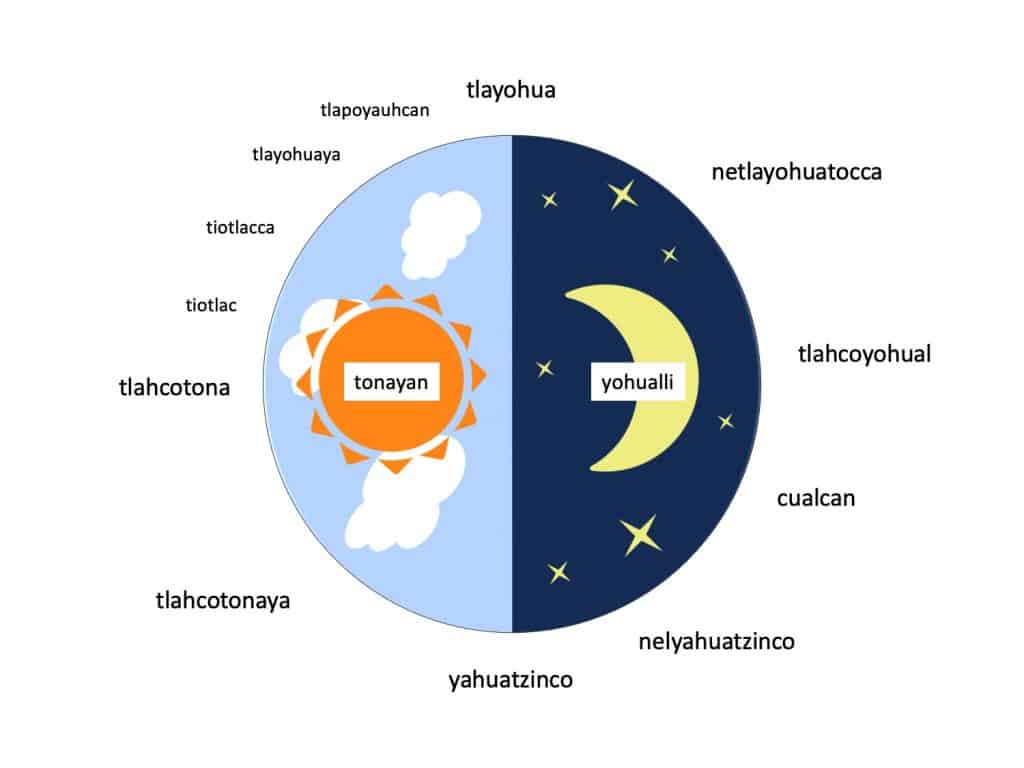In this lesson we will learn day times and the names of various everyday activities. We will also look at how indigenous elders turn to the movement of the sun to determine the time of day.
Mercado de Chicontepec CC BY COERLL Nahuatl
Below is the division of the day in the Nahuatl language:

tlayo9huaya “it is almost night”
tlapoyauhcan “it is evening”
nelyāhuatzinco “very early”
Tlamānēxtilli Ce (Example One)
Yāhuatzinco “Morning”
Īcā yāhuatzinco Juana mēhua pan chicuacē cāhuitl tlen achtohui quichīhua mīxxamia huan motlancochpahpāca. Teipan quimāna īcafen noque molōni, ya mopatla, quēmman eltocca īcafen quiōni.
Answer the following questions:
- Tlen cāhuitl mēhua Juana?
- Tlen quichīhua Juana achtohui?
- Tlen quiōni Juana?
Tlamānēxtilli Ōme (Example Two)
Tlahcotōna “Midday”
Maria tlahcōtona tlacualchīhua huanya inanān, inanān quimāna etl huan Maria quitehtequi chīlli, colantoh huan cebollah. Quēmman iuccicca etl inanān quitzoyōnia, huan Maria pēhua tlatehtēca. Teipan tlacuāh.
Answer the following questions:
- Tlahcotōna _____________Maria huanya __________.
- Maria _________ chīlli, ____________ huan _______________.
- Ācquiya quitzoyōnia etl? _________________.
Tlamānēxtilli Ēyi (Example Three)
Tiotlac “Evening”
Ramón quēmman itztoc mīllah cemilhuitl huan quēmman quinequi mocuapaz īchān zan quiitta ītōnal īcā tōnatiuh cānin eltoc huan moilliz eltoc nahui cāhuitl tiotlac. Inihhuantin axcanah mocahcayāhuah. Huan quēmman ax quīza tōnatiuh nouhquiya inihhuantin quinehnehuiah zan iuhquinon.
Answer the following questions:
- Cānin itztoc Ramón?
- Tlen quichīhua Ramón para quimatiz tlen cāhuitl?
- Tlen quiitta Ramón quēmman quinequi mocuapaz īchān?
Tlamānēxtilli Nahui (Example Four)
Tlayōhua “Night”
Pan tlayōhua niccuā cē pantzin huan nicōni cafen, teipan nicchīhua chāntequitl huan quēmman niman nitlami nouhquiya nitlahtzoma cē quēntzin. Quēmman nicochihza niquitta tlamāhuizolli.
Choose the correct answer:
| 1. Tlen niccuā tlayōhua? | ||
| a) tlaxcalli | b) pantzin huan chocolātl | c) pantzin huan cafen |
| 2. Tlen nicchīhua teipan quēmman tlami niccuā pantzin huan cafen? | ||
| a) nitlahtzoma | b) chāntequitl | c) tlamāhuizoa |
| 3. Tlen nicchīhua quēmman nicochihza? | ||
| a) tlahtzoma | b) tlamāhuizoa | c) tlacuā |

